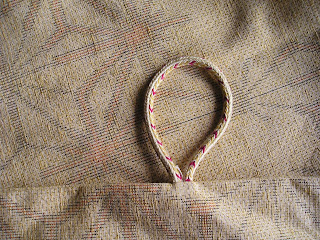角組はかっちりとして実用的で、しかも美しい組み方です。正倉院にも数多くの角組の組紐が残されています。画像が小さくて見にくいのですが、正倉院の宝物データベースに小香袋が載っています。可愛い小袋ですね。ちょっと真似して作ってみたいと思わせます。
写真の上2本は、ビデオで作っていた2色の角組と同じもの、一番下の茶系のものは、これも正倉院の組紐を真似て作ったものです。これは、ループの上と下の糸が異なる2色ループで組んでいます。この作り方は近いうちに説明します。
私は台組みの経験がないのですが、台で角組を組むには4の倍数の要素数(ループの場合は1ループが2要素になる)で組むのが通常だそうです。しかし、昭和48年(1973年)に平凡社から発行された「正倉院の組紐」によると、当時調査された正倉院の240例の角組の内、要素数が4の倍数ものは78例、奇数の倍数のものは160例と圧倒的に奇数の倍数のものが多いそうです。私たちは8本のループ(要素数16)で角組を作りましたが、奇数の倍数(10,14,18、すなわちループ数で言うと5,7,9本)で組むことももちろんできます。従って、正倉院の角組はループ組紐の手法で組まれたと、木下雅子先生は書いておられます。(正倉院紀要第31号)
実は、8本ループの角組の断面は台形をしています。4面の内、広い面と狭い面が向かい合っていることに気づきます。ところが、7本や9本のループで組んだ角組の方がより正方形に近い断面になります。是非比べてみてください。従って、きれいな角組を組みたければ、奇数ループで組む方が良いわけです。これも、正倉院の角組がループ組紐の手法で組まれたとする根拠の1つに木下先生は挙げておられます。さらに2つの根拠を木下先生は挙げておられますが、何しろ私は台組ができないものですから、よく理解できておりません。台組をしておられる方々は、是非この論文を読んでみてください。
深く理解できないながら、ループ組紐が奈良時代あるいはそれ以前の昔から用いられた手法であり、この手法で組まれたものを、今も私たちは、ガラス越しではあるものの、見ることができるということに、私はロマンを感じます。そして、自分が今動かしている手の動きは、古代の組紐製作者らと同じだと思うと、何だか、時代を超えた仲間意識すら感じてしまいます。
さらに、角組は世界中で組まれてきたそうです。話は大きくなるので、今日はここまでといたしましょう。
Kakugumi is
not only a strong and practical braid, but also it is beautiful. In Shosoin (the ancient treasure warehouse
attached to Todaiji (Great Buddha) Temple in Nara which dates back to the 8th
century), a number of Kakugumi Kumihimo are preserved. One of them, though not very clear, is a small incense bag which we can see from the Shosoin Database. A lovely small bag that makes me feel like
sewing and braiding a similar one myself.
The two top
ones in the photo are the same Kakugumi that I made in the video, and the
bottom one I made copying another treasure Kakugumi from Shosoin. I will explain how to make it in the near
future.
I do not have
an experience of braiding with Marudai, but I read that in order to braid
Kakugumi with Marudai, you usually use multiples of 4 elements (in case of loop
braid, one loop has two elements) .
However, according to the book “Braids in the Shoso-in” published in
1973 by Heibosha, among the 240 Kakugumi braids in Shosoin that they had
examined, there were 78 braids with multiples of 4 elements whereas 160 braids
were made with multiples of odd-number elements, overwhelming majority!
Though we have practiced an 8-loop Kakugumi, we can easily make a Kakugumi with multiples
of odd-number elements (10, 14, and 18, which are 5, 7, and 9 loops). Based on
this fact, Masako Kinoshita Sensei writes in her paper submitted to Shosoin that Kakugumi restored in Shosoin were made using loop
braiding techniques. I am afraid I could
not find the English translation of the paper.
In fact, if
you look at an 8-loop Kakugumi carefully, you will notice that it is trapezoid
in cross-section. It has a wide and narrow sides facing each other. On the other hand, the braids with 7 or 9
loops are more square in cross-section.
Please compare your Kakugumi.
Therefore, if you want to make a fair square Kakugumi, you would choose
odd-number loop Kakugumi. This is
another reason why Kinoshita-sensei believes that Shosoin Kumihimo are made
using loop braiding technique. She also
shows two more reasons to support her idea.
But unfortunately because of my lack of Marudai experience, I do not
quite understand her points. I recommend
that those who can braid with Marudai should read her paper.
In spite of
the fact that I do not fully understand her logics, I am still fascinated that
loop braiding is a very old technique going back over 1300 years, and the
resulting works we can still watch today, though through glass, at the Nara
National Museum. Besides, when I think
that the movements of my braiding fingers are the same as those of the ancient
braiders, I even feel some kind of comradeship with those unseen craftsmen and craftswomen.
I also heard
that Kakugumi has been braided for a long time all over the world, but the
story is long and I would like to call it a day now.

































